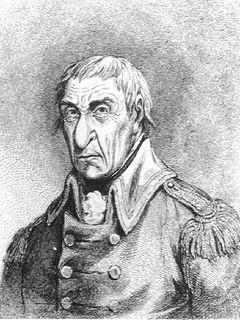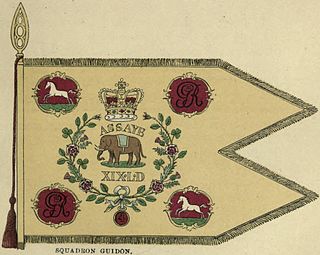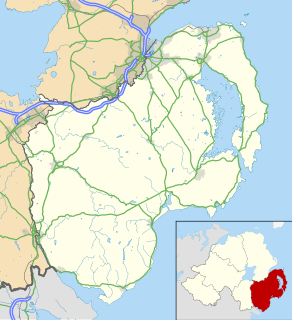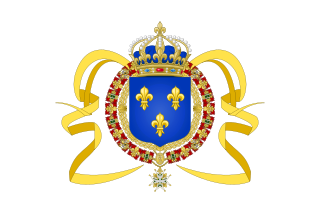
James Napper Tandy was an Irish revolutionary, and member of the United Irishmen.

The Anglo-Nepalese War (1814–16), also known as the Gurkha War, was fought between the Kingdom of Gorkha and the East India Company as a result of border disputes and ambitious expansionism of both the belligerent parties. The war ended with the signing of the Treaty of Sugauli in 1816, which ceded some Nepalese controlled territory to the British.

Peter Buell Porter was an American lawyer, soldier and politician who served as United States Secretary of War from 1828 to 1829.

Sir William Pepperrell, 1st Baronet was an American merchant and soldier in Colonial Massachusetts. He is widely remembered for organizing, financing, and leading the 1745 expedition that captured the French garrison at Fortress Louisbourg during King George's War. During his day Pepperrell was called "the hero of Louisburg," a victory celebrated in the name of Louisburg Square in Boston's Beacon Hill neighborhood. He is the great-great-great grandfather of actor Robert Hardy.

The Battle of San Pasqual, also spelled San Pascual, was a military encounter that occurred during the Mexican–American War in what is now the San Pasqual Valley community of the city of San Diego, California. The series of military skirmishes ended with both sides claiming victory, and the victor of the battle is still debated. On December 6 and December 7, 1846, General Stephen W. Kearny's US Army of the West, along with a small detachment of the California Battalion led by a Marine Lieutenant, engaged a small contingent of Californios and their Presidial Lancers Los Galgos, led by Major Andrés Pico. After U.S. reinforcements arrived, Kearny's troops were able to reach San Diego.

The Wolseley expedition was a military force authorized by Sir John A. Macdonald to confront Louis Riel and the Métis in 1870, during the Red River Rebellion, at the Red River Colony in what is now the Canadian province of Manitoba. The expedition was also intended to counter American expansionist sentiments in northern border states. Leaving Toronto on in May 1870, the expedition arrived at Fort Garry on August 24, 1870. After a journey of three months in arduous conditions, the Expedition arrived at, and captured, Fort Garry. This extinguished Riel's Provisional Government, and eradicated the threat of the American expansion into western Canada.
Shezada Hyder Ali was the grandson of Hyder Ali and the eldest son of Abdul Kareem.

John William Egerton, 7th Earl of Bridgewater FRS, known as John Egerton until 1803, was a British cavalry officer, and Tory politician who sat in the House of Commons from 1777 to 1803 when he succeeded to the peerage as Earl of Bridgewater. He was from the Egerton family.
General Sir John William Floyd, 1st Baronet, was a British cavalry officer.

The Madras Army was the army of the Presidency of Madras, one of the three presidencies of British India within the British Empire.

The 19th Light Dragoons was a cavalry regiment of the British Army created in 1781 for service in British India. The regiment served in India until 1806, and in North America during the War of 1812, and was disbanded in Britain in 1821.
William Reeves was an Irish antiquarian and the Church of Ireland Bishop of Down, Connor and Dromore from 1886 until his death. He was the last private keeper of the Book of Armagh and at the time of his death was President of the Royal Irish Academy.

The Vellore mutiny on 10 July 1806 was the first instance of a large-scale and violent mutiny by Indian sepoys against the East India Company, predating the Indian Rebellion of 1857 by half a century. The revolt, which took place in the South Indian city of Vellore lasted one full day, during which mutineers seized the Vellore Fort and killed or wounded 200 British troops. The mutiny was subdued by cavalry and artillery from Arcot. Summary executions of about 100 mutineers took place during the suppression of the outbreak, followed by the formal court-martial of smaller numbers.

General James Welsh was an English officer in the Madras Army of the East India Company.

The Battle of Nalapani was the first battle of the Anglo-Nepalese War of 1814–1816, fought between the forces of the British East India Company and Nepal, then ruled by the House of Gorkha. The battle took place around the Nalapani fort, near Dehradun, which was placed under siege by the British between 31 October and 30 November 1814. The fort's garrison was commanded by Captain Balbhadra Kunwar, while Major-General Rollo Gillespie, who had previously fought in the Battle of Java, was in charge of the attacking British troops. Gillespie was killed on the first day of the siege while rallying his men and despite considerable odds, both in terms of numbers and firepower, Balbhadra and his 600-strong garrison successfully held out against more than 5,000 British troops for over a month.
Lieutenant-General Sir (Horace) Rollo (Squarey) Pain was a British Army officer who commanded 2nd Division.

General Sir John Ormsby Vandeleur was a British Army officer who fought in the French Revolutionary and Napoleonic wars.
Black Bob was a horse which was a mascot of the Eighth King's Royal Irish Light Dragoons mentioned in military history of the period. Black Bob was the horse of Sir Rollo Gillespie and had been foaled of an Irish mare at the Cape of Good Hope. Gillespie was killed while riding the horse at the Battle of Kalunga. The horse was put up for sale in the saddle and trappings still stained with Gillespie's blood and purchased by troops of the Irish Dragoons themselves and became a regimental mascot. On retirement he was sold to a civilian at Cawnpore.
The Very Rev. Cadogan Keatinge, MA was an Anglican priest in Ireland in the second half of the 18th-century.




















